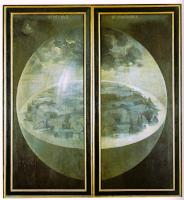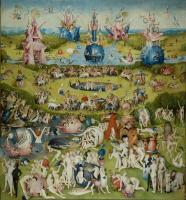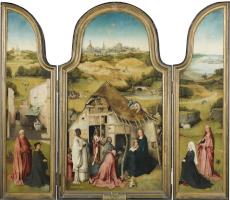Hieronymous Bosch
The Flemish painter Hieronymus Bosch was one of the world’s greatest masters of fantasy. His haunted work, full of monsters and devils, reflected the superstitious and religious beliefs which had survived from the early Middle Ages. He fathered no school of followers in his own time, although he was a distinguished artist, but his influence has continued for nearly five hundred years, and is easy to detect in the work of the Surrealists of the twentieth century.
Four paintings on a series of folding panels make up The Garden of Earthly Delights. When the outer wings are closed we see the Third Day of Creation (or, according to a recent interpretation, the destruction of the earth by flood). When the wings are opened they reveal astonishing scenes in subtle colour and mesmerizing detail. On the left is the Garden of Eden, in the centre the Garden of Earthly Delights, which is thought to depict the world before the Flood, and on the right a terrifying vision of Hell.
 The meaning of the work as a whole is uncertain, but the sense of a powerful
allegory is beyond doubt. Over half of Bosch’s surviving paintings have
religious subjects, and his work can only be interpreted in a religious
framework; his art was, as a Spanish cleric remarked, ‘a painted satire on the
sins and ravings of man’. It studied those human feelings which in the Middle
Ages were thought to be the result of divine or devilish inspiration. Bosch
was painting at the climax of a period when people firmly believed in the
existence of grotesque demons; it was also a time of robust, even cruel humour.
The meaning of the work as a whole is uncertain, but the sense of a powerful
allegory is beyond doubt. Over half of Bosch’s surviving paintings have
religious subjects, and his work can only be interpreted in a religious
framework; his art was, as a Spanish cleric remarked, ‘a painted satire on the
sins and ravings of man’. It studied those human feelings which in the Middle
Ages were thought to be the result of divine or devilish inspiration. Bosch
was painting at the climax of a period when people firmly believed in the
existence of grotesque demons; it was also a time of robust, even cruel humour.
This great work, with its imaginary buildings, landscapes of parks and gardens and dark fire-lit inferno, exposes humanity in a truly terrifying light. In the central panel a wild sexual orgy is depicted showing every imaginable aspect of lust, the cause of man’s downfall, and revealing his ignorance and corruption. Writhing human bodies are dwarfed by massive birds, fish and fruits: one figure carries off another on his back in a huge mussel shell; a man and a woman are encased in a bubble on the back of a strange sea creature; strawberries, fish, flowers, exotic birds and animals are all involved with men and women in the act of love. People can be seen riding an assortment of animals in a ring in the middle distance: pigs, camels, horses, goats, unicorns and strange unrecognizable creatures that are part-animal, part-bird. In the work as a whole there are something like a thousand human figures.
Bosch’s dazzling inventiveness seems endless. He has created an extraordinary, fascinating fantasy world, full of weird exaggerations and distortions, but he has done it with such care and detail that he has turned its nightmarish terrors into reality.





